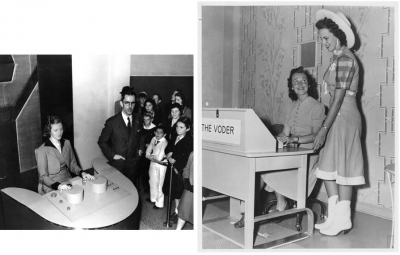
On June 5, 1938, “Pedro, the Voder was put on display to the public for the first time at the Franklin Institute, Philadelphia One of the first devices to create human speech, the Voder was a successful experiment in reproducing speech electronically.
We are far too used to machine-made voices speaking to us in today’s world. Be it the automated responses that are provided to us when we call for customer support. personal assistants in our smartphones, or various devices that support a smart home ecosystem, there are plenty of examples in our everyday lives.
While we don’t often pause to think about these, there are instances when we talk about the technologies with a mixture of fear and reverence. That mixture of feelings was first experienced by human beings with the success of “Pedro, the Voder’.
Voice Operation Demonstrator
Voder is short for Voice Operation Demonstrator. Named “Pedro” after the Brazilian emperor Dom Pedro who is believed to have exclaimed “My God! It talks!” after listening to a telephone for the first time, the Voder was one of the first devices to bring us entirely synthetic speech.
The Voder was the brainchild of pioneering engineer Homer Dudley, an acoustic visionary and an inventor at Bell Labs. He rose to prominence in the 1920s when he created the popular “channel” vocoder. This was capable of coding human speech across telephone lines by transforming incoming speech into electrical signals and then replicating it on the other end by using electric sounds that mimicked human speech.
Artificial human sound
With the Voder, Dudley went one step further as this device was able to produce speech without human voice as an input. Dudley filed a patent for a system for the artificial production of vocal or other sounds in April 1937. Weeks before this patent was granted to him, the Voder had its first public demonstration at the Franklin Institute in Philadelphia on June 5, 1938.
The Voder was operated – or played according to its creators – to create about 20 different electric sounds. By using 10 keys, a wrist plate, and a pedal, the operator could orchestrate the electric sounds to make them sound like speech and even create a range of inflections.
Operating the Voder, however, was no easy feat as it required thinking about how sounds combine to form a word, and how subtle inflection changes alter the meaning. In fact, the Voder was almost entirely operated by a Helen Harper, who was also responsible for teaching the 20-30 people who ever learnt how to use it.
Crowds amazed
During the presentations at the Franklin Institute, the 1939 New York World’s Fair, and San Francisco’s Golden Gate International Exposition, Harper was seated behind a console as she worked her magic. She was able to make the voder speak statements and ask questions; say the same sentence using different inflections; make its voice sound like a female, male, or like an old person; or even mimic a cow. Making the voder recite “Mary had a little lamb” in all of its different voices was a popular trick that the bell Labs team employed.
Bell Labs, however, never meant to sell the machine as a commercial product and only used it as a proof of concept. This meant that it vanished following its successful tours of various venues. Apart from leaving the audience with a sense of wonder, Bell Labs was able to show that the Voder was capable of making electrical vibrations that translated into sound waves in the loudspeaker, without needing to manipulate air. Speech synthesis and machine-made human voices have come a long way since then.
Picture Credit : Google




